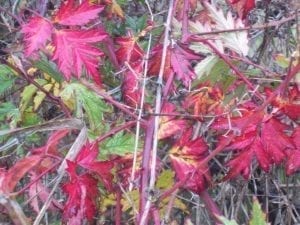 We just set the clocks back for fall. This causes upheaval in schedules and personal timing for sleeping, eating, and more. I wondered, what does this mean to my body? Isn’t time just a construct of culture? How do I connect to time with my senses?
We just set the clocks back for fall. This causes upheaval in schedules and personal timing for sleeping, eating, and more. I wondered, what does this mean to my body? Isn’t time just a construct of culture? How do I connect to time with my senses?
On a recent morning a warm wind invited me to eat breakfast outside on the deck. As I sat, I watched the greyscale landscape gain color. First, I noticed a brightening of the sky, not quite pink, but a blush to the grey. Then I could distinguish the red-orange leaves of the cherry trees and blueberry bushes. They glowed while the other leaves in the woods were still colorless. (I recommend the article on The Nature of Observing in Astronomy Magazine July 2015. Author Stephen James O’Meara discusses in detail changes in colors at dawn and twilight. www.astronomy.com) Then the yellow leaves of the walnut and maple trees began to show, until I realized I was looking now at a color landscape. My vision saw time move forward in the day.
Now that I think of it, time displays itself throughout the day in the slant of the sunlight, the length or absence of shadows. Whether the sun sets behind the fir tree or into the mountain tells me where we are in the year, in our cycle around the sun.
Are my eyes my only sense organ to register time? How do I read time with my internal senses? I eat, and over time, my body processes the raw materials and extracts nutrients. I sense full, empty, gut, bowel, bladder. My joints and muscles tell me when sitting in one position has been long enough, when it’s time to move.
In the film The Martian (and novel by Andy Weir), the astronaut stranded on Mars measures time with discipline: how much he is allowed to eat each day to make the food supply last until his rescue, or until his next crop of potatoes matures; how much time he can drive in the rover before he has to stop and let the solar panels re-charge; how long he can sleep before it’s time to drive again.
Do I use time in discipline as well? Most mornings I spend some time sitting quietly and breathing. I have often thought of this period in my day as my time “off clock”, in which I ignore the numbers. Yet after a while I sense in my body and my mind a sort of deepening. Something changes and I am less easily distracted by thoughts. There seems to be a minimum amount of clock time before this occurs. Perhaps mostly a measure of my lack of ability to drop in right away, this phenomenon is a sort of internal measure of time.
While quietly breathing in the morning, I feel as though my body is less susceptible to the pull of gravity. If the downward pull is one measure of aging, of how our bodies respond over a lifetime of living on earth, then am I suspending time in those moments? Surely, most of my biological processes continue. And the sun continues its daily journey.
Time is a healer. When I am injured, even if the pain is intense, my experience tells me that the pain will lessen and even disappear over time. Knowing that time is one of the ingredients of healing, I invoke patience… but I also often apply techniques to shorten the healing time. I send Ki, or the energy of life force (Oregon Ki society.org), or move with The Nia Technique (nianow.com), seeking how I can move without discomfort, creating even tiny shifts that feel better.
Breathing is a measure of time. Often employed to bring attention to the present moment, each breath also marks the passage of time. In yoga class, instead of telling students to maintain a pose for a certain number of seconds or minutes, the instructor may suggest staying in a pose for a certain number of breaths. Breaths feel “real” to me, counting comes back to the human invention of time.
I just returned from the International Council on Active Aging annual convention (icaa.cc). I was surrounded by amazing people dedicated to changing the way we age. I don’t think we strive to arrest time. We seek ways to improve the experience of aging, maintaining activity, dignity, health, vitality, gusto. Viewing wellness as more than physical, including social, emotional, vocational, environmental, spiritual, and intellectual aspects as well, perhaps we are improving time. Ha – I remember the poem referenced in Alice In Wonderland – “How doth the little busy bee, improve each shining hour…?” and then chuckle over Alice’s version when under the influence of the hallucinogens offered on her adventure, so that the poem changes to, “How doth the little crocodile, improve his shining tail, and pour the waters of the Nile on every golden scale.” The precious ingredient of humor improves the hour as well, providing resilience, an ability to rebound from difficult situations.
Is resilience, one of my personal key words, related to time?
I don’t know. What I do know, in my own experience, is that the more flexibility I retain, both physical and emotional, the more inclined I am to stay around in this life. I look forward to more mornings watching the colors of the day awake. I look forward to more Nia classes and Nia Training dates, where I grow along with my students.
